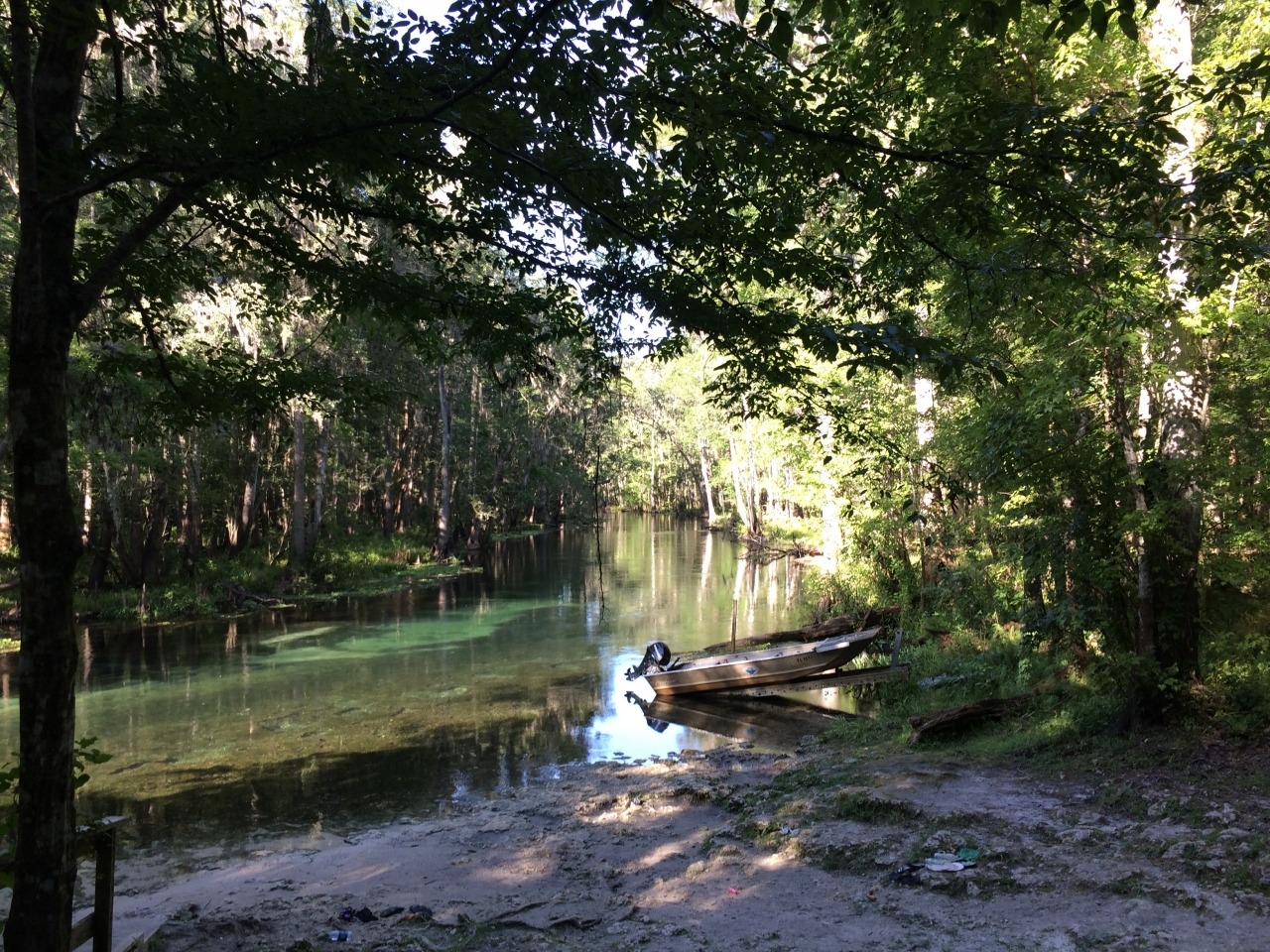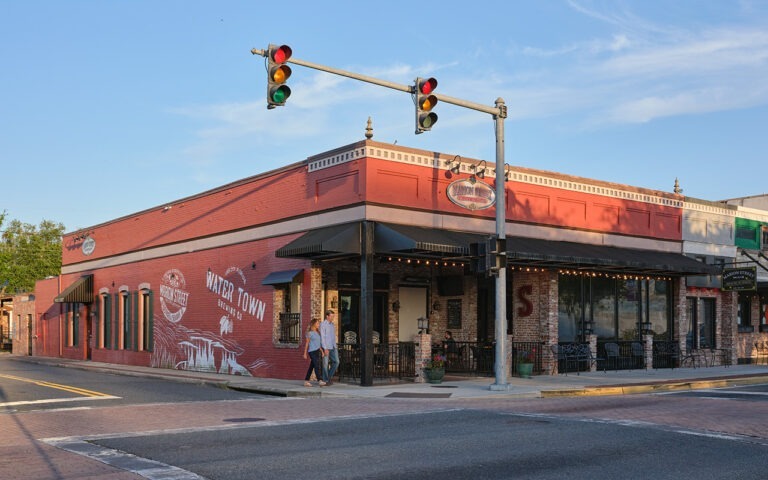Springs are only part of it. While Columbia County only has one city and one town, it has historic architecture, wonderful back roads, natural beauty and wildlife, birdwatching along the Great Florida Birding Trail, and two state parks, one of which is among the most popular in Florida.
But most travelers miss this. Caught in the momentum of I-10 and I-75, they see Lake City and its neighbors as just a series of billboards and exit signs flashing by. But if you’re someone who enjoys the thrill of discovery, ease off the accelerator, take the first exit, and discover the wonders of Columbia County.
A good place to start? The county seat.
In the Heart of Lake City
In downtown Lake City, a smattering of shops including art galleries, a corner café, and stores selling art supplies, folk art, gifts, jewelry, and antiques fill a number of storefronts. Near the shops in Olustee Square, a Florida heritage marker tells of the town that began as a Seminole village called Alligator Town.
Actually, the translated Seminole name was Alpata Telophaka and honored Chief Halpatter Tustenuggee (known as ‘Alligator’ by white men) who was credited for devising the Dec. 28, 1835 attack that became known as the Dade City Massacre. After Alligator and his warriors killed 104 of the 107 troops, the U.S. government launched the Second Seminole War and things didn’t end well for the Seminoles. By the time the Civil War began, the town’s name had been changed to Lake City and the unconquered tribe had left their village and found refuge in the Everglades.
Although the Civil War was seldom fought in Florida, it was only a few miles from here that the Battle of Olustee took place in neighboring Baker County on Feb. 20, 1864. A stone monument by the Columbia County Courthouse remembers the 151 Confederate soldiers who fought and died there. Their bodies moved from the battlefield, they now rest in peace at the Oaklawn Cemetery 10 blocks northwest of downtown.
Just east of the courthouse, a lovely circular lake may well have been the inspiration for the city’s new name – and was definitely a gathering place for a group of disgruntled Confederates. During Reconstruction some townspeople expressed their disgust at the presence of federal troops by stealing several of their Springfield rifles and tossing them in the water. In 1982, divers fished 16 Union rifles out of Lake DeSoto. A more genteel gathering takes place near the lake each weekend at the Lake DeSoto Farmers Market. From 9 a.m. to 1 p.m. each Saturday, vendors sell baked goods, dairy products (cheese, milk, eggs), and locally sourced organic produce – with many items grown in simple backyard gardens.
Local history is shared a few blocks south at the Lake City-Columbia County Historical Museum (157 SE Hernandez Ave., Thursdays and Saturdays 10 a.m. – 1 p.m., 386/755-9096). Inside the two-story Italianate house, a small museum features Civil War artifacts including photographs, firearms, and journals, Native American memorabilia, and rooms decorated with period pieces. Staff can also assist visitors with genealogical research. Hours vary, so call ahead.
Down the street, dozens of late 1800s-early 1900s homes comprise the 30-block Lake Isabella Historic Residential District, which is highlighted by a picturesque and inviting pond that attracts locals who relax at picnic tables beneath the shade of sprawling oaks.
A Walk in the Park
Soon after heading south on US 441, Columbia’s scenic countryside arrives. The drive is soothing and calming and it’s a pleasure to find a country road that links Lake City to one of Florida’s first state parks.
Located 21 miles south of Lake City (five miles south of I-75), it’s natural to connect O’Leno State Park (386/454-1853) with the comedian, but the name is actually a contraction of ‘Old Leno,’ a village with stores, a hotel, grist mills, saw mills, cotton gins and a post office that turned into a ghost town when the railroad was diverted to nearby Fort White in 1894.
A beautiful canopy road that leads to the entrance hints at the tranquility that lies ahead. Just past the ranger station, signs advise drivers to watch for deer and gopher tortoises, both of which share the woodlands with native birds and their migrating cousins who pass through these parts along the Great Florida Birding Trail. The distinct Old Florida feeling you’ll sense is likely because this park was created as part of a Civilian Conservation Corps project. It’s worth noting that what FDR’s crew created between 1934 and 1941 continues to show Florida in its best light, and a small museum that tells their story is open daily from 9-3.
Where the Santa Fe River runs through the park, swimmers ease into the tea-colored waters from a floating dock, some guests renting canoes and kayaks to explore the waterway. Spanning the river, the ‘swinging bridge’ actually does what it promises, creaking from side to side and adding a slight thrill as you cross it.
This scenic bridge, as well as a line of trees that sweeps along the river’s bend, provide numerous photo ops as you explore the park. A short distance downstream, water splashes over a small dam and on each bank, fishermen stand on the exposed roots of oak trees and cast their lines. Wonderful for a day visit, to fully appreciate the park consider staying over. Two camping loops include 61 campsites that can accommodate primitive campers as well as RVs. A great option for educational school trips and church retreats, the historic group camp has more than a dozen sleeper cabins with bunk beds as well as two bathhouses, a fully-equipped dining hall, recreation hall, basketball hoop, volleyball net, horseshoe court, BBQ pit, and fire ring.
The State of ‘Flow-rida’
People who love natural outdoor recreation love Ichetucknee Springs State Park (386/497-4690). Located on the outskirts of Fort White (Columbia County’s only incorporated town), it holds a special place in the hearts of many Floridians due to its beauty, its purity, and its simplicity.
The concept is simple: Within the park’s borders, a crystal-clear river flows for 3.5 miles from the main spring. Traveling via floats and inner tubes, your voyage takes you gently down the stream and places you within the most tranquil scenery on earth. As you go with the flow, sunlight flickers through a canopy of oaks. In the glassy waters, lengthy strands of eelgrass wave in the current and fish and turtles swim calmly below. It is altogether a Zen experience.
When you feel warm, slide off the inner tube and slip into the 72-degree water. When you’re chilled, slip back onto the float and let the sun and the breeze warm you. It’s as pure and magical an experience as you can have in Florida.
Odds & Ends
Explore Columbia County’s more rural areas, and you’ll find a few of its unincorporated towns including
• Lulu. Ten miles southeast of Lake City on Highway 100, this dot of a community is notable for the Mount Zion Slave Cemetery you’ll see on the northeast side of the road.
• Mikesville. You’ll pass this small community 18 miles south of Lake City on US 441. If your name is Mike, the sign at the town entrance may persuade you to stop for a photo.
• Watertown: Less than three miles east of Lake City, the highlight here is 46-acre Watertown Lake which is filled with bass, blue gill, brim and more.




